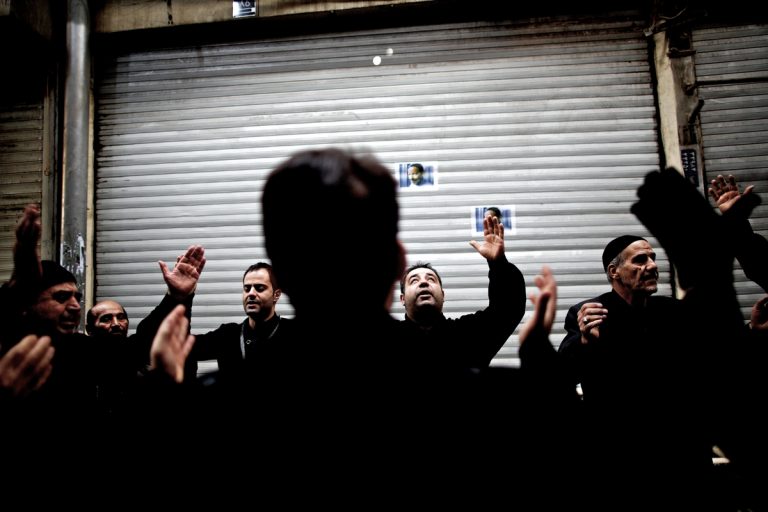
Image by Behrouz Mehri/Getty Images.
Every Day Is Ashura: The Possibility of Dying With Honor
If a spiritual path is to offer us a holistic path to the Divine Beloved, it has to have a way of accounting for every emotion, every spiritual state. We are told in the Bible that to everything there is a season:
To every thing there is a season,
and a time to every purpose under the heaven:
A time to be born, and a time to die;
a time to plant, and a time to pluck up that which is planted;
A time to kill, and a time to heal;
a time to break down, and a time to build up;
A time to weep, and a time to laugh;
a time to mourn, and a time to dance;
So much of the spiritual path of Islam is about living in a state of grace and gratitude. No, all of the path is about grace and gratitude. But so much of the path is about living in a state of healing and joyously living in full grace. There is almost always an awareness that we are to live in the world as the Divine Beloved would have us live.
And then, every now and then, there is a time to weep. A time to mourn. A time to die.
Every now and then there is an awareness that some things are simply not as God would have them be, that there is the blood of innocents shed, that there is genuine injustice and suffering, and it is not right. Every now and then, there is the time to rise up against that injustice, even at the cost of our own fame, reputation, or even life.
If we have to die, let us die beautifully. Let us die with purpose.
So many traditions talk about living with purpose and grace. But it is also possible to die beautifully, to die with honor. If we have to give our lives for a cause, let us die with dignity and honor.

We are living in the week of the Islamic calendar where this quality is most beautifully embodied. This is the week that all Muslims, Sunni and Shi’a alike, commemorate and honor the martyrdom of the beautiful grandson of the Prophet Muhammad, Imam Hussain. Let us probe its mysteries a bit, for few have ever managed to both live and die heroically in such a beautiful, dignified fashion.
Less than 50 years after the passing away of the Prophet Muhammad, the grandson of Muhammad (and some 72 of his friends and family members of the Prophet) rode into the Iraqi desert to rise up against an unjust Muslim ruler. They knew full well that they would be treated as rebels, and would be shown no mercy.
Soon, a small remnant of his family found themselves captives of the rulers of the Muslim state. They were confronted with an overpowering army, had most their men killed, the women dishonored, and the few survivors dragged through the Iraqi desert. Among those martyred was the very grandson of the Prophet Muhammad, Imam Hussain, who died a heroic and tragic death, seeing most of his loved ones killed before him.
Their path to this destination involved a procession humiliating for them, and horrific for those who saw it. This gruesome scene involved the army of ruling powers of the Muslim state, the Umayyads, marching en masse from the plains of Karbala to Kufa. According the respected historian Tabari, their soldiers had hoisted the severed heads of 72 of the family members of the Prophet Muhammad on lances. Violating Islamic rules dealing with mutilation of bodies, the soldiers were publicly parading the raised severed heads, and the few survivors, through the cities of Kufa, before making their way to the seat of the empire in Damascus.
In Kufa, the few surviving members of the family of the Prophet were standing before Ibn Ziyad, who ruled there by the authority of the Umayyad ruler named Yazid. In a shocking scene that was almost unbelievable to most of those present, Ibn Ziyad was presented with the captives, and a tray. On the tray was the severed and bloodied head of the very grandson of Prophet Muhammad, Hussain.
When the bloodied head of Imam Hussain was brought to Ibn Ziyad’s court in Kufa, the cruel tyrant took his cane and mockingly struck the lips of the severed head of Hussain, as if to taunt the fallen grandson of the Prophet. An old man in the crowd, named Zayd, the son of Arqam, who had been a longtime follower of the Prophet Muhammad, was unable to control himself any more, stepped forth even though it broke all courtly decorum, and shouted at the ruler:
Remove your cane from these lips!
By God,
I have seen the Prophet of God,
kissing this face.
This was the same Hussain whom the Prophet, as a tender grandfather, loved so deeply. This was the same Hussain who would climb on the Prophet’s back when he would be bent over in prayer. This was the same Hussain whose face the Prophet would kiss again and again, saying, “Hussain is of me, and I am of Hussain.”
Now Hossein’s body was on the ground in Karbala,
trampled by horses.
And Hossein’s bloody head sat on a silver platter,
before Muslim rulers.

How could something like this happen? How could a religion of justice and mercy have gone so wrong, so quickly?
How did it happen? How did the Muslim community go from lovingly gathering around Muhammad to killing his precious grandchildren in less than two generations? And if we are to understand the full meaning of this cosmically significant event, how could the Muslim today kill today’s Hussain? How could the religion of love and justice and mercy be used so savagely in the hands of those for whom it is but a means of domination, violence, and tyranny?
Every day is Ashura.
Every place is Karbala.
These issues are at the very heart of the martyrdom of Hussain, an event that matters as much about the then as it does about the eternal now.
There are events in world history where the significance of what takes place far outstrips its mere historicity. A first-century Palestinian Jew, the son of a carpenter, is hung between two thieves at the behest of Roman authorities, and today over a billion Christians see the crucifixion of Christ as the ultimate symbol of God’s deliverance of humanity from sin. Six centuries before Christ, an Indian prince sat under a tree, vowing not to move until he had transcended the cycles of birth and rebirth. Today hundreds of millions of Buddhists look at the enlightenment of Siddhartha Buddha as the very model of how to rise above attachment and ignorance.
The martyrdom of Imam Hussain was such an event. At face value, it represented the massacre of 72 people at the behest of a corrupt and violent ruler. It would not be the first, nor the last, time that the blood of innocents has been shed on this Earth. And yet for many Muslims, particularly for those who call themselves the Shi’a, the martyrdom of Imam Hussain on the tenth day of each Muharram (referred to as Ashura) is indeed a cosmic event whose significance is far greater than merely something in the remote plains of seventh-century Iraq.
In all such cases — the crucifixion of Christ, the awakening of the Buddha, and the martyrdom of Hussain — these events become a symbol, a map, of something fundamental about the nature of universe: that there is sin and it must be redeemed, that there is attachment and suffering and it must be transcended, and that there is injustice and one has the cosmic responsibility to rise up against it.
A time to weep, and a time to laugh;
a time to mourn, and a time to dance;
In all of these cases, what happened there is also projected against all time and space. Christians look not back at the crucifixion of Jesus, but see that act of redemption as shaping their lives here and now. For Buddhists, the key is not how that Indian prince became awakened, but rather how we are to be enlightened. And for Muslims the question is not what Hussain did on the plains of Karbala in Iraq in the month of Muharram of the year 680, but rather what are we doing today.
This is the power of religious imagination, which makes every place a sacred place, and every day a sacred time. An Iranian intellectual of the middle of the 20th century said it best:
Every day is Ashura.
Every place is Karbala.

May we remember that in order to avoid fossilizing Ashura, we should remember that the real question is not just what Imam Hussain did in the month of Muharram of the year 680 on the plains of Karbala in Iraq, but rather what we are doing today.
Honoring Imam Hussain is not merely by shedding tears for that Hussain of the seventh century, but rather by “carving a tunnel of hope through the great mountain of despair,” as other teachers have reminded us. It is to look around us today, and look for the Hussains among us, in Syria, inner-city America, Yemen and Palestine, Pakistan, and Iraq.
Where does Hussain bleed today? Everywhere. Everywhere. Everywhere.
What would best serve the cause of Imam Hussain and Islam is not just to sit in mourning but rather to rise in protest, rise majestically like Imam Hussain against all the Yazids of the world today. The Yazids of the world are sometimes individuals every bit as devious as Yazid of yesteryear, but more often they are entities and concepts like oppression, greed, occupation, militarism, brutality, violence, and every oppressive ideology that stands in the way of affirming the dignity and integrity of each and every member of humanity.
There are Hosseins today. In every corner of the Earth where there are the marginalized and the poor of the Earth, there are those who bear the perfume of Hussain. And everywhere there are Yazids of today who oppress the Hussain-like meek of the Earth, and shed the blood of innocents.
May all these Yazids, literal and metaphorical, be upended on this and every Ashura, so that we can realize the daily relevance of the teachings of a beautiful and meaningful redemptive and revolutionary faith. May we rise, majestically, to embody the spirit of a love and justice revolution, in countering tyranny and oppression. We may avoid the trap of what some have called pious irrelevancies, and cultivate a potent, politically aware, spiritually charged, effective, and affective faith that is put to the service of today’s Hussains.
Every day is Ashura,
Every place is Karbala.Every day is Ashura,
Every place is Karbala.

Let our lives be filled with grace and mercy. May our lives be meaningful, and purposeful. And if we have to die, may our deaths be also filled with grace and mercy, filled with purpose.
Yes, there is a time for mourning, a time for weeping. Let us give thanks for those who remind us of the heroic sacrifice, quite literally: making sacred. Let us be grateful for those who made their lives and deaths sacred by putting the wellbeing of others ahead of their own.
Today, Sunni Muslims and Shi’a Muslims alike commemorate this heroic sacrifice, and in places even compete with one another in sectarian ways to see who best mourns Hussain’s sacrifice. If we are to compete, let us do so with dignity, with honor, with principle, and for the cause of justice and righteousness so that our very lives bring dignity to our stances.
Every day is Ashura,
Every place is Karbala.

Share your reflection